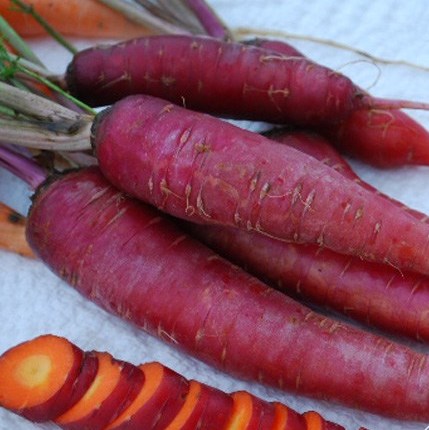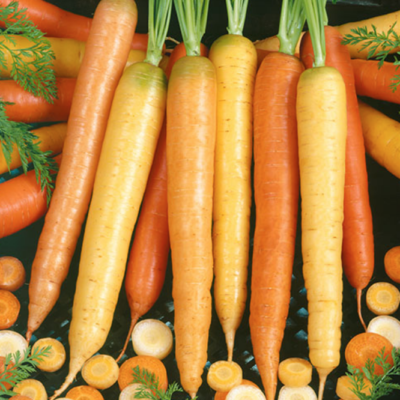
Learning Download: How to Grow Carrots
From Seed to Harvest: A beginner’s guide to growing carrots.
Carrots bring bountiful nutrients to the table, as well as a burst of color. Other than the typical orange, carrots can be found in red, white, rainbow and purple colors. Carrots are rich in vitamin A, which helps prevent poor eyesight. In addition to being a tasty treat to humans, they also make a healthy treat for pets.
To plant:
Plant carrot seeds 3-4 inches apart in rows set a foot apart, with the seeds 1/4 inch deep. Carrots can be planted three to five weeks before the last frost date in the spring. Applying manure before planting seeds can cause carrots to shoot out roots from their bodies. To prevent this, do not apply manure prior to planting the seeds. Also, make sure the soil is loose and tilled deeply. If stones are in the way, they can stunt a carrot’s growth or cause them to grow in a misshapen fashion.
To grow:
When plants reach 1 inch tall, thin the plants to be 3 inches apart. Instead of pulling out the plants, snip the tops with scissors to not damage nearby roots. Mulch can be spread lightly around the carrots. Keep up on weeding, and fertilizer can be used five weeks after planting.
Carrots should continue growing through a few frosts, as it enhances the flavor. After the first fall frost, cover the carrots with shredded leaves but leave them in the ground.
To harvest:
Carrots are ready for harvest two-and-a-half months after planting, when their diameter reaches about a half-inch. However, after they mature, carrots can be stored where they grow in the ground for an additional four weeks before they must be harvested.
Grabbing the leaves and pulling the carrot can rip the foliage off the vegetable, so loosen the soil around the carrot with a fork first. For storage, leave about 1/2 inch of green leaf at the top of the carrot, then rinse and dry the carrot before storing in the refrigerator.
What carrots crave:
Carrots prefer full sunlight, but they can grow in partial shade. They require at least 1 inch of water per week, and they do best in sandier soils with a pH of 6.0 to 6.8.
Where to buy carrot seeds:
You can find many varieties of carrot seeds in red, white, orange, purple and rainbow colors at Urban Farmer.
Learning Download: Common pests and diseases: Carrots
Common pests and diseases: Carrots
When growing vegetables, it is always exciting to care for the plant throughout its growing phase and then harvest it for delicious recipes later on, but one thing to watch out for is pests and diseases. Different plants are susceptible to different types of pests and diseases, and is is important to make yourself aware so you can keep a watchful eye and also take any preventative methods to keep your plants safe throughout their lifespan.
Carrots can fall victim to several different pests and diseases.
Pests:
There are quite the variety of pests that can affect the carrot, and these include carrot rust, carrot weevils, parsleyworms and nematodes.
Carrot rust is caused by carrot rust flies. The flies lay their eggs in the soil around where the top of the carrot plants come through. When the eggs hatch, the larvae then burrow into the soil and into the roots of the carrot, where they eat leaving rust-colored tunnels in the lower portion of the roots.
Carrot weevils are similar to a beetle and they lay eggs that when they hatch, burrow into the carrot like the carrot rust, but they typically affect the upper portion of the carrot.
Parsleyworms are caterpillars that eat the top growth of the carrot.
Nematodes are roundworms that live in the soil that when they affect the carrots, they can cause poorly formed roots, galls and root branching. The nematodes only occur if the soil is warmer than 55 degrees. A way to prevent these are to plant your carrots early, when the soil is still cool. Preventing pests is possible by using a row cover to help deter harmful pests from landing on your carrots or carrot tops.

Diseases:
Since carrots are root vegetables and grow mostly below ground, not all diseases affecting this vegetable are obvious at first unless the disease affects the top growth of the plant.
Carrots can be affected by several diseases, including aster yellows disease, leaf blight and bacterial soft rot.
Aster yellows disease is caused by an organism called a phytoplasma. This is carried by the aster leafhopper, and it causes leaf yellowing, stunted growth that causes short, bushy growth and it destroys the carrot’s flavor. To prevent this, prevent the leafhopper from landing on the carrots by using row covers.
Leaf blight is caused by a fungus, and it also attacks tomatoes. It causes yellow and brown spots, and these can merge and make the leaf tops look burned.
Bacterial soft rot is a soil-borne-bacteria that eats chunks of the carrot. To prevent this, practice crop rotation and be sure to immediately remove the plant as soon as you notice an infection.

